UTS 92443: Exploring Substance Use Disorders Through a Blog
VerifiedAdded on 2022/09/25
|8
|2100
|29
Project
AI Summary
This assignment presents a blog written from the perspective of Amelia, a 25-year-old Indigenous Australian college student, detailing her struggle with substance use disorder. The blog entries chronicle her experiences with binge drinking, smoking, and clubbing, including the development of dependence, the impact on her academics and mental health, withdrawal symptoms, and her journey through cognitive-behavioral therapy (CBT). Amelia reflects on her regrets, the influence of peer pressure and parental habits, and the challenges of maintaining social relationships. The blog explores the risk factors, effects of substance use, and the process of seeking professional help, including the interventions used in CBT such as motivational interventions, contingency management, and relapse prevention techniques. The assignment concludes with Amelia's insights gained, her future nursing aspirations, and specific actions she plans to take to raise awareness, promote early intervention, and offer support to those affected by substance use disorders. The assignment adheres to the guidelines of the assignment brief which requires accurate understanding of the disease and its trajectory, and requires the use of first-person narrative style.
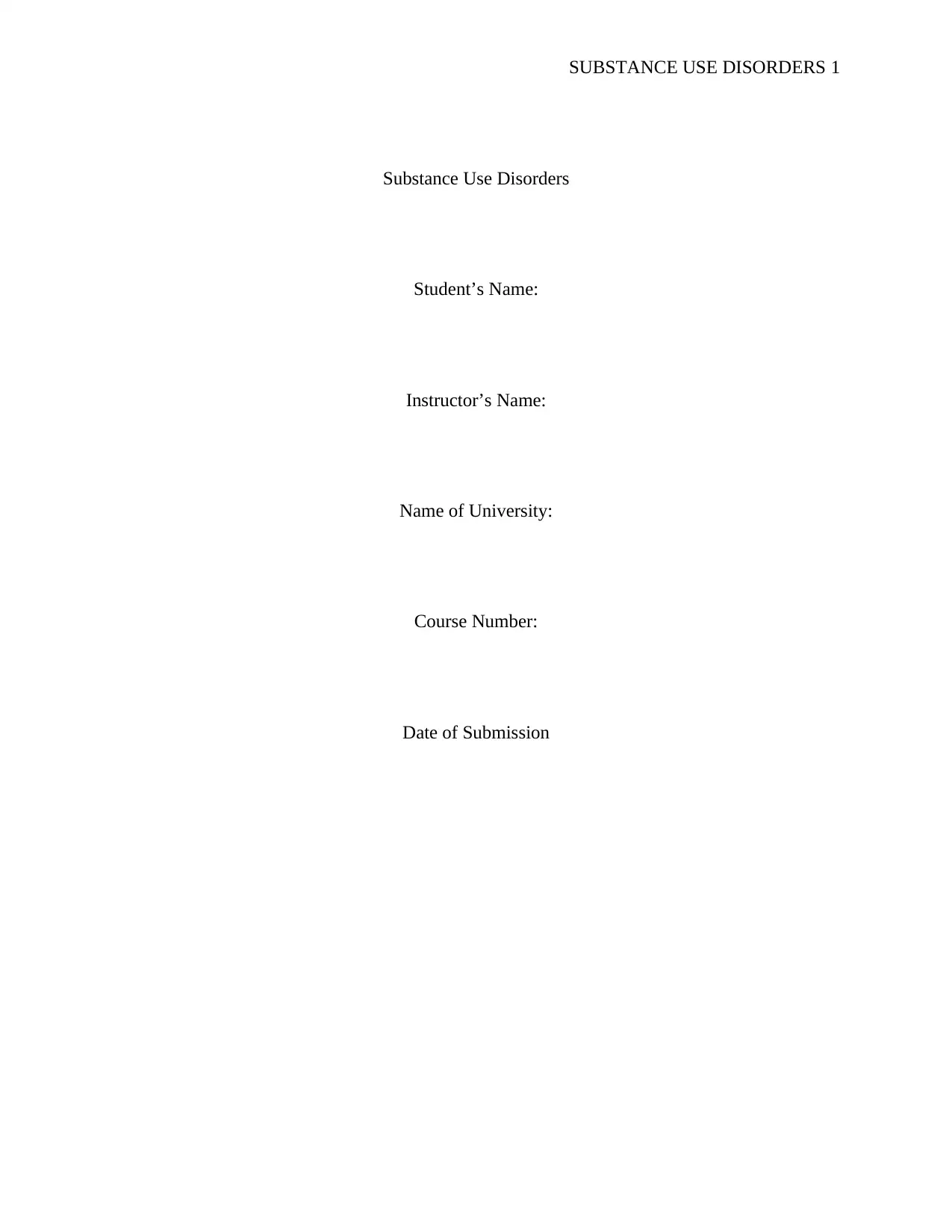
SUBSTANCE USE DISORDERS 1
Substance Use Disorders
Student’s Name:
Instructor’s Name:
Name of University:
Course Number:
Date of Submission
Substance Use Disorders
Student’s Name:
Instructor’s Name:
Name of University:
Course Number:
Date of Submission
Paraphrase This Document
Need a fresh take? Get an instant paraphrase of this document with our AI Paraphraser

SUBSTANCE USE DISORDERS 2
Introduction
Substance use disorders consist of impaired control over the use of drugs with sustained
use notwithstanding significant psychological and physical difficulties. Substance use disorders
can either be dependent or harmful. Dependence use is related to symptoms such as tolerance to
the consumption of alcohol and drugs and suffering from withdrawal symptoms among others
(McGorry, Purcell, Goldstone, & Amminger, 2011). On the other hand, harmful use involves the
use of a drug until it leads to physical or psychological harm. According to the Australian
Institute of Health and Welfare (2020), there was an increase in the number of smokers who had
developed mental health conditions and psychological distress between 2013 and 2016. The
survey reported 22% of chain smokers and who were twice likely to develop severe
psychological distress than non-smokers. The percentage of tobacco smokers increased between
2013 and 2016 and this corresponded with an increase in mental sickness and psychological
distress by at least 5%. Consumers of alcohol self-reported higher levels of psychological
distress (16.1%) than non-alcoholics (9.3%) (Calabria et al., 2010).
Background
My name is Amelia and I am a female college student aged 25 years old. I am an
Indigenous Australian of the Gadigal descent living in Sydney. I currently stay alone but usually
pay visits to my parents and siblings in the northern part of Sydney. I was born and raised in
Sydney, though my parents moved to the city thirty years ago. I am light-skinned, blonde-haired
and four-five inches tall. I work part-time in the restaurants within the city and also attend
college. My leisure activities include binge drinking, smoking, and clubbing. Since I am a
student and part-time worker, I only get involved in the pleasure activities during the weekend.
Introduction
Substance use disorders consist of impaired control over the use of drugs with sustained
use notwithstanding significant psychological and physical difficulties. Substance use disorders
can either be dependent or harmful. Dependence use is related to symptoms such as tolerance to
the consumption of alcohol and drugs and suffering from withdrawal symptoms among others
(McGorry, Purcell, Goldstone, & Amminger, 2011). On the other hand, harmful use involves the
use of a drug until it leads to physical or psychological harm. According to the Australian
Institute of Health and Welfare (2020), there was an increase in the number of smokers who had
developed mental health conditions and psychological distress between 2013 and 2016. The
survey reported 22% of chain smokers and who were twice likely to develop severe
psychological distress than non-smokers. The percentage of tobacco smokers increased between
2013 and 2016 and this corresponded with an increase in mental sickness and psychological
distress by at least 5%. Consumers of alcohol self-reported higher levels of psychological
distress (16.1%) than non-alcoholics (9.3%) (Calabria et al., 2010).
Background
My name is Amelia and I am a female college student aged 25 years old. I am an
Indigenous Australian of the Gadigal descent living in Sydney. I currently stay alone but usually
pay visits to my parents and siblings in the northern part of Sydney. I was born and raised in
Sydney, though my parents moved to the city thirty years ago. I am light-skinned, blonde-haired
and four-five inches tall. I work part-time in the restaurants within the city and also attend
college. My leisure activities include binge drinking, smoking, and clubbing. Since I am a
student and part-time worker, I only get involved in the pleasure activities during the weekend.

SUBSTANCE USE DISORDERS 3
I aspire to be a registered nurse in the future so as to offer healthcare services to the
Indigenous Australians who are so preservative to their culture. I do not ascribe to any religious
beliefs neither do my parents. My major regrets in life are attributed to my lifestyle. I regret the
first time I tasted alcohol and had the first puff of cigarette smoke. It was out of peer pressure but
little did I know that it will reach the present condition of addiction. Furthermore, my addiction
to substance use has led me to a lot of trouble including arrests and accidents. I could also smoke
at intervals of three house whether at work or school.
Blog Entries
Blog 1: Dependence and risk factors
I remember it was on a Friday evening after I had checked-out from my work station and
received an invitation call from my friends to a party. I quickly rushed to my house, dressed up
and left for the party. The only thing I remember is my arrival to the party and the first few
bottles of alcohol that I drank because I found myself on a hospital bed the following day. Nurses
told me that I drank too much alcohol until I became unconscious. It is at this point that I began
to realize that I was developing a dependence on substance use. The physician came and asked
me several questions including how frequent do I drink or smoke, whether there is an increase in
the use of the substance, how I manage to drink, party, attend school and work, and any risk
factors that I am aware of (Hasin et al., 2013). I was introduced to drug and substance abuse by
my friends who potentially influenced my beliefs about drugs. I can also attribute my drinking to
the early influence of my parents who also drink regularly. I used to see my parents drink at
home over the weekends, even though we were not allowed to taste. After the diagnosis, the
doctor called my parents and notified them of the incidence and I was discharged and advised to
watch my lifestyle.
I aspire to be a registered nurse in the future so as to offer healthcare services to the
Indigenous Australians who are so preservative to their culture. I do not ascribe to any religious
beliefs neither do my parents. My major regrets in life are attributed to my lifestyle. I regret the
first time I tasted alcohol and had the first puff of cigarette smoke. It was out of peer pressure but
little did I know that it will reach the present condition of addiction. Furthermore, my addiction
to substance use has led me to a lot of trouble including arrests and accidents. I could also smoke
at intervals of three house whether at work or school.
Blog Entries
Blog 1: Dependence and risk factors
I remember it was on a Friday evening after I had checked-out from my work station and
received an invitation call from my friends to a party. I quickly rushed to my house, dressed up
and left for the party. The only thing I remember is my arrival to the party and the first few
bottles of alcohol that I drank because I found myself on a hospital bed the following day. Nurses
told me that I drank too much alcohol until I became unconscious. It is at this point that I began
to realize that I was developing a dependence on substance use. The physician came and asked
me several questions including how frequent do I drink or smoke, whether there is an increase in
the use of the substance, how I manage to drink, party, attend school and work, and any risk
factors that I am aware of (Hasin et al., 2013). I was introduced to drug and substance abuse by
my friends who potentially influenced my beliefs about drugs. I can also attribute my drinking to
the early influence of my parents who also drink regularly. I used to see my parents drink at
home over the weekends, even though we were not allowed to taste. After the diagnosis, the
doctor called my parents and notified them of the incidence and I was discharged and advised to
watch my lifestyle.
⊘ This is a preview!⊘
Do you want full access?
Subscribe today to unlock all pages.

Trusted by 1+ million students worldwide
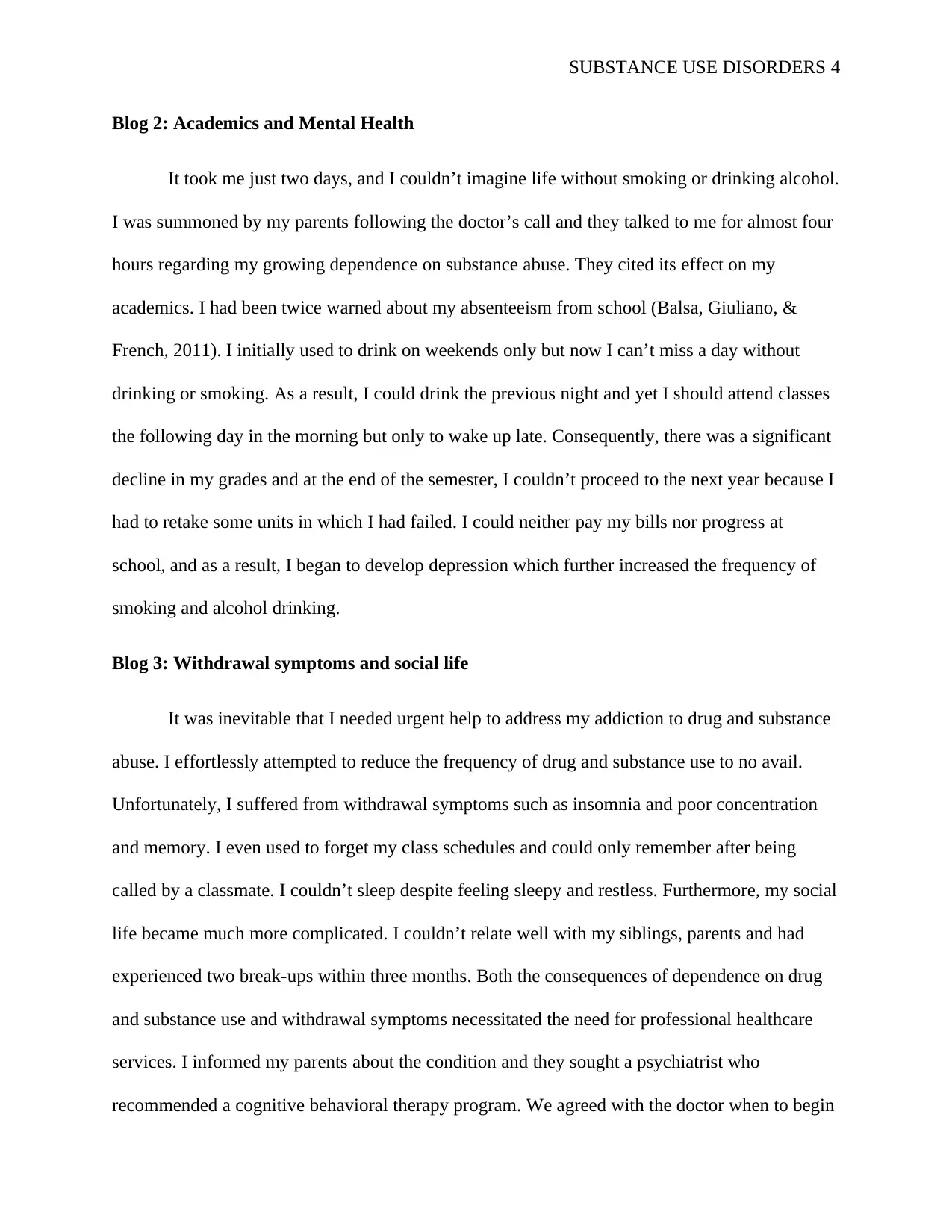
SUBSTANCE USE DISORDERS 4
Blog 2: Academics and Mental Health
It took me just two days, and I couldn’t imagine life without smoking or drinking alcohol.
I was summoned by my parents following the doctor’s call and they talked to me for almost four
hours regarding my growing dependence on substance abuse. They cited its effect on my
academics. I had been twice warned about my absenteeism from school (Balsa, Giuliano, &
French, 2011). I initially used to drink on weekends only but now I can’t miss a day without
drinking or smoking. As a result, I could drink the previous night and yet I should attend classes
the following day in the morning but only to wake up late. Consequently, there was a significant
decline in my grades and at the end of the semester, I couldn’t proceed to the next year because I
had to retake some units in which I had failed. I could neither pay my bills nor progress at
school, and as a result, I began to develop depression which further increased the frequency of
smoking and alcohol drinking.
Blog 3: Withdrawal symptoms and social life
It was inevitable that I needed urgent help to address my addiction to drug and substance
abuse. I effortlessly attempted to reduce the frequency of drug and substance use to no avail.
Unfortunately, I suffered from withdrawal symptoms such as insomnia and poor concentration
and memory. I even used to forget my class schedules and could only remember after being
called by a classmate. I couldn’t sleep despite feeling sleepy and restless. Furthermore, my social
life became much more complicated. I couldn’t relate well with my siblings, parents and had
experienced two break-ups within three months. Both the consequences of dependence on drug
and substance use and withdrawal symptoms necessitated the need for professional healthcare
services. I informed my parents about the condition and they sought a psychiatrist who
recommended a cognitive behavioral therapy program. We agreed with the doctor when to begin
Blog 2: Academics and Mental Health
It took me just two days, and I couldn’t imagine life without smoking or drinking alcohol.
I was summoned by my parents following the doctor’s call and they talked to me for almost four
hours regarding my growing dependence on substance abuse. They cited its effect on my
academics. I had been twice warned about my absenteeism from school (Balsa, Giuliano, &
French, 2011). I initially used to drink on weekends only but now I can’t miss a day without
drinking or smoking. As a result, I could drink the previous night and yet I should attend classes
the following day in the morning but only to wake up late. Consequently, there was a significant
decline in my grades and at the end of the semester, I couldn’t proceed to the next year because I
had to retake some units in which I had failed. I could neither pay my bills nor progress at
school, and as a result, I began to develop depression which further increased the frequency of
smoking and alcohol drinking.
Blog 3: Withdrawal symptoms and social life
It was inevitable that I needed urgent help to address my addiction to drug and substance
abuse. I effortlessly attempted to reduce the frequency of drug and substance use to no avail.
Unfortunately, I suffered from withdrawal symptoms such as insomnia and poor concentration
and memory. I even used to forget my class schedules and could only remember after being
called by a classmate. I couldn’t sleep despite feeling sleepy and restless. Furthermore, my social
life became much more complicated. I couldn’t relate well with my siblings, parents and had
experienced two break-ups within three months. Both the consequences of dependence on drug
and substance use and withdrawal symptoms necessitated the need for professional healthcare
services. I informed my parents about the condition and they sought a psychiatrist who
recommended a cognitive behavioral therapy program. We agreed with the doctor when to begin
Paraphrase This Document
Need a fresh take? Get an instant paraphrase of this document with our AI Paraphraser
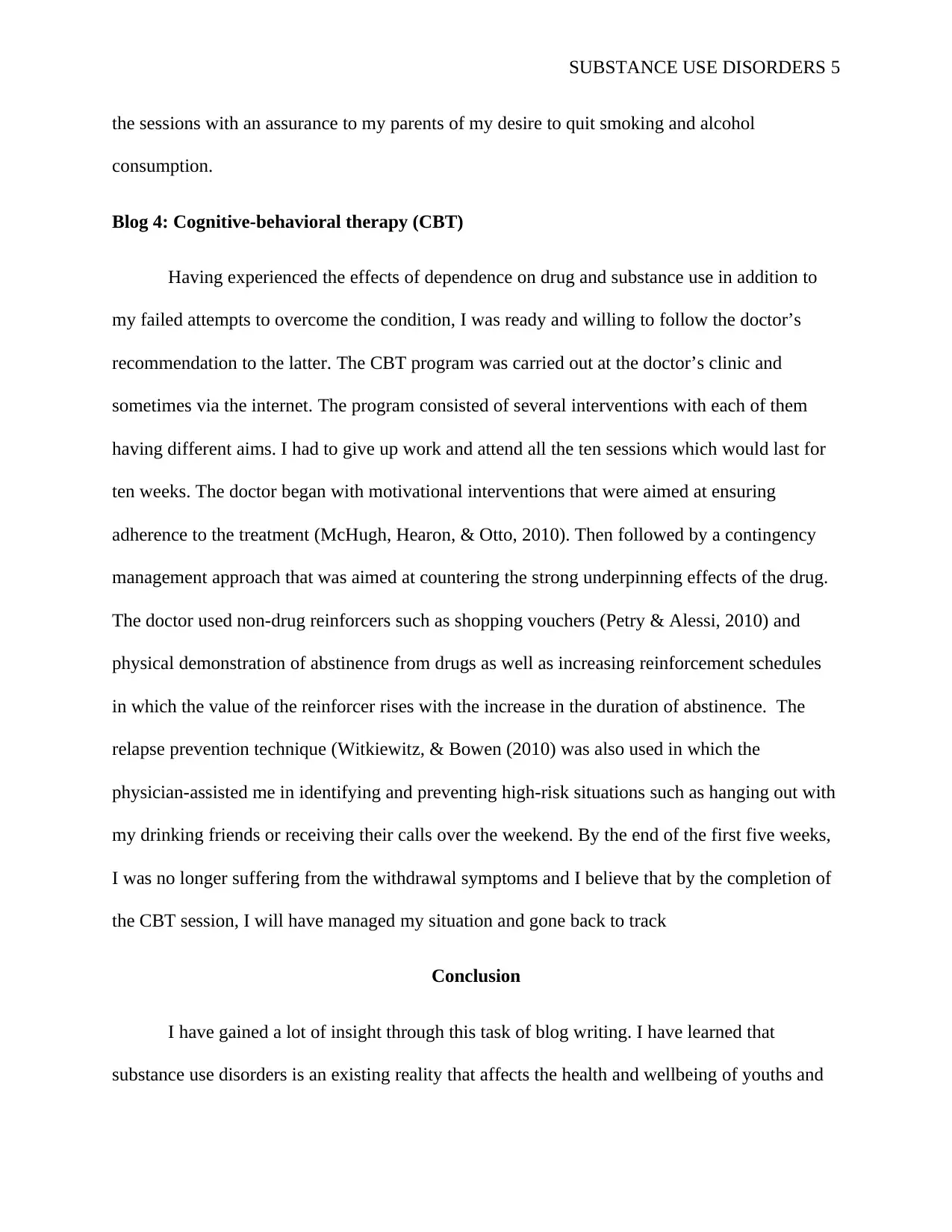
SUBSTANCE USE DISORDERS 5
the sessions with an assurance to my parents of my desire to quit smoking and alcohol
consumption.
Blog 4: Cognitive-behavioral therapy (CBT)
Having experienced the effects of dependence on drug and substance use in addition to
my failed attempts to overcome the condition, I was ready and willing to follow the doctor’s
recommendation to the latter. The CBT program was carried out at the doctor’s clinic and
sometimes via the internet. The program consisted of several interventions with each of them
having different aims. I had to give up work and attend all the ten sessions which would last for
ten weeks. The doctor began with motivational interventions that were aimed at ensuring
adherence to the treatment (McHugh, Hearon, & Otto, 2010). Then followed by a contingency
management approach that was aimed at countering the strong underpinning effects of the drug.
The doctor used non-drug reinforcers such as shopping vouchers (Petry & Alessi, 2010) and
physical demonstration of abstinence from drugs as well as increasing reinforcement schedules
in which the value of the reinforcer rises with the increase in the duration of abstinence. The
relapse prevention technique (Witkiewitz, & Bowen (2010) was also used in which the
physician-assisted me in identifying and preventing high-risk situations such as hanging out with
my drinking friends or receiving their calls over the weekend. By the end of the first five weeks,
I was no longer suffering from the withdrawal symptoms and I believe that by the completion of
the CBT session, I will have managed my situation and gone back to track
Conclusion
I have gained a lot of insight through this task of blog writing. I have learned that
substance use disorders is an existing reality that affects the health and wellbeing of youths and
the sessions with an assurance to my parents of my desire to quit smoking and alcohol
consumption.
Blog 4: Cognitive-behavioral therapy (CBT)
Having experienced the effects of dependence on drug and substance use in addition to
my failed attempts to overcome the condition, I was ready and willing to follow the doctor’s
recommendation to the latter. The CBT program was carried out at the doctor’s clinic and
sometimes via the internet. The program consisted of several interventions with each of them
having different aims. I had to give up work and attend all the ten sessions which would last for
ten weeks. The doctor began with motivational interventions that were aimed at ensuring
adherence to the treatment (McHugh, Hearon, & Otto, 2010). Then followed by a contingency
management approach that was aimed at countering the strong underpinning effects of the drug.
The doctor used non-drug reinforcers such as shopping vouchers (Petry & Alessi, 2010) and
physical demonstration of abstinence from drugs as well as increasing reinforcement schedules
in which the value of the reinforcer rises with the increase in the duration of abstinence. The
relapse prevention technique (Witkiewitz, & Bowen (2010) was also used in which the
physician-assisted me in identifying and preventing high-risk situations such as hanging out with
my drinking friends or receiving their calls over the weekend. By the end of the first five weeks,
I was no longer suffering from the withdrawal symptoms and I believe that by the completion of
the CBT session, I will have managed my situation and gone back to track
Conclusion
I have gained a lot of insight through this task of blog writing. I have learned that
substance use disorders is an existing reality that affects the health and wellbeing of youths and
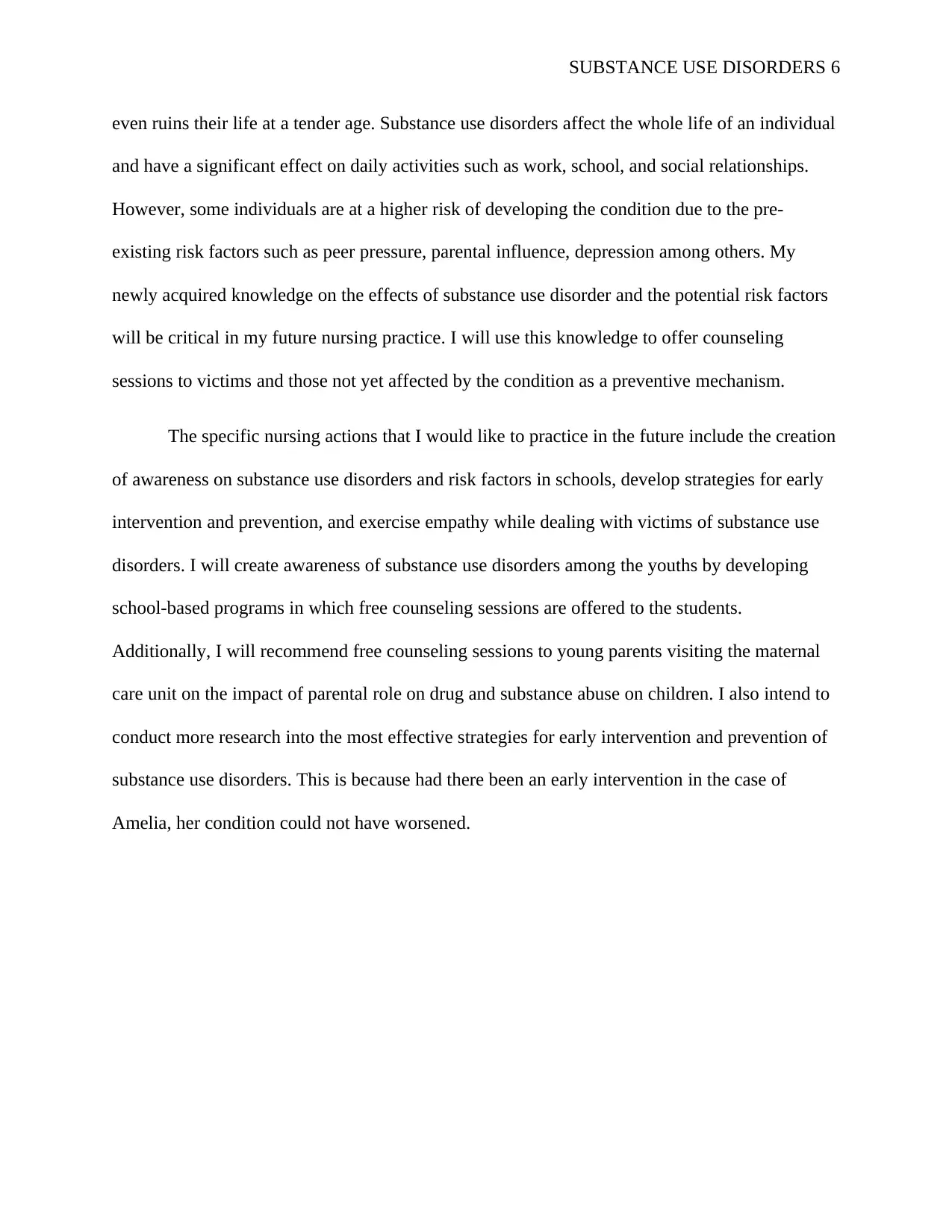
SUBSTANCE USE DISORDERS 6
even ruins their life at a tender age. Substance use disorders affect the whole life of an individual
and have a significant effect on daily activities such as work, school, and social relationships.
However, some individuals are at a higher risk of developing the condition due to the pre-
existing risk factors such as peer pressure, parental influence, depression among others. My
newly acquired knowledge on the effects of substance use disorder and the potential risk factors
will be critical in my future nursing practice. I will use this knowledge to offer counseling
sessions to victims and those not yet affected by the condition as a preventive mechanism.
The specific nursing actions that I would like to practice in the future include the creation
of awareness on substance use disorders and risk factors in schools, develop strategies for early
intervention and prevention, and exercise empathy while dealing with victims of substance use
disorders. I will create awareness of substance use disorders among the youths by developing
school-based programs in which free counseling sessions are offered to the students.
Additionally, I will recommend free counseling sessions to young parents visiting the maternal
care unit on the impact of parental role on drug and substance abuse on children. I also intend to
conduct more research into the most effective strategies for early intervention and prevention of
substance use disorders. This is because had there been an early intervention in the case of
Amelia, her condition could not have worsened.
even ruins their life at a tender age. Substance use disorders affect the whole life of an individual
and have a significant effect on daily activities such as work, school, and social relationships.
However, some individuals are at a higher risk of developing the condition due to the pre-
existing risk factors such as peer pressure, parental influence, depression among others. My
newly acquired knowledge on the effects of substance use disorder and the potential risk factors
will be critical in my future nursing practice. I will use this knowledge to offer counseling
sessions to victims and those not yet affected by the condition as a preventive mechanism.
The specific nursing actions that I would like to practice in the future include the creation
of awareness on substance use disorders and risk factors in schools, develop strategies for early
intervention and prevention, and exercise empathy while dealing with victims of substance use
disorders. I will create awareness of substance use disorders among the youths by developing
school-based programs in which free counseling sessions are offered to the students.
Additionally, I will recommend free counseling sessions to young parents visiting the maternal
care unit on the impact of parental role on drug and substance abuse on children. I also intend to
conduct more research into the most effective strategies for early intervention and prevention of
substance use disorders. This is because had there been an early intervention in the case of
Amelia, her condition could not have worsened.
⊘ This is a preview!⊘
Do you want full access?
Subscribe today to unlock all pages.

Trusted by 1+ million students worldwide

SUBSTANCE USE DISORDERS 7
References
Australian Institute of Health and Welfare (AIHW). (2020) ‘Alcohol, tobacco & other drugs in
Australia’, Cat. no: PHE 221. Canberra: AIHW. Available at:
https://www.aihw.gov.au/reports/alcohol/alcohol-tobacco-other-drugs-australia/contents/priority-
populations/young-people (Accessed: 16 April 2020).
Balsa, A. I., Giuliano, L. M., & French, M. T. (2011) ‘The effects of alcohol use on academic
achievement in high school’, Economics of education review, 30(1), 1-15.
Calabria, B., Doran, C. M., Vos, T., Shakeshaft, A. P., & Hall, W. (2010) ‘Epidemiology of
alcohol‐related burden of disease among Indigenous Australians’, Australian and New Zealand
journal of public health, 34, S47-S51.
Hasin, D. S., O’Brien, C. P., Auriacombe, M., Borges, G., Bucholz, K., Budney, A., ... &
Schuckit, M. (2013), ‘DSM-5 criteria for substance use disorders: recommendations and
rationale’, American Journal of Psychiatry, 170(8), 834-851.
McGorry, P. D., Purcell, R., Goldstone, S., & Amminger, G. P. (2011) ‘Age of onset and timing
of treatment for mental and substance use disorders: implications for preventive intervention
strategies and models of care’ Current opinion in psychiatry, 24(4), 301-306.
McHugh, R. K., Hearon, B. A., & Otto, M. W. (2010) ‘Cognitive behavioral therapy for
substance use disorders’, Psychiatric Clinics, 33(3), 511-525.
Petry, N. M., & Alessi, S. M. (2010) ‘Prize-based contingency management is efficacious in
cocaine-abusing patients with and without recent gambling participation’ Journal of substance
abuse treatment, 39(3), 282-288.
References
Australian Institute of Health and Welfare (AIHW). (2020) ‘Alcohol, tobacco & other drugs in
Australia’, Cat. no: PHE 221. Canberra: AIHW. Available at:
https://www.aihw.gov.au/reports/alcohol/alcohol-tobacco-other-drugs-australia/contents/priority-
populations/young-people (Accessed: 16 April 2020).
Balsa, A. I., Giuliano, L. M., & French, M. T. (2011) ‘The effects of alcohol use on academic
achievement in high school’, Economics of education review, 30(1), 1-15.
Calabria, B., Doran, C. M., Vos, T., Shakeshaft, A. P., & Hall, W. (2010) ‘Epidemiology of
alcohol‐related burden of disease among Indigenous Australians’, Australian and New Zealand
journal of public health, 34, S47-S51.
Hasin, D. S., O’Brien, C. P., Auriacombe, M., Borges, G., Bucholz, K., Budney, A., ... &
Schuckit, M. (2013), ‘DSM-5 criteria for substance use disorders: recommendations and
rationale’, American Journal of Psychiatry, 170(8), 834-851.
McGorry, P. D., Purcell, R., Goldstone, S., & Amminger, G. P. (2011) ‘Age of onset and timing
of treatment for mental and substance use disorders: implications for preventive intervention
strategies and models of care’ Current opinion in psychiatry, 24(4), 301-306.
McHugh, R. K., Hearon, B. A., & Otto, M. W. (2010) ‘Cognitive behavioral therapy for
substance use disorders’, Psychiatric Clinics, 33(3), 511-525.
Petry, N. M., & Alessi, S. M. (2010) ‘Prize-based contingency management is efficacious in
cocaine-abusing patients with and without recent gambling participation’ Journal of substance
abuse treatment, 39(3), 282-288.
Paraphrase This Document
Need a fresh take? Get an instant paraphrase of this document with our AI Paraphraser
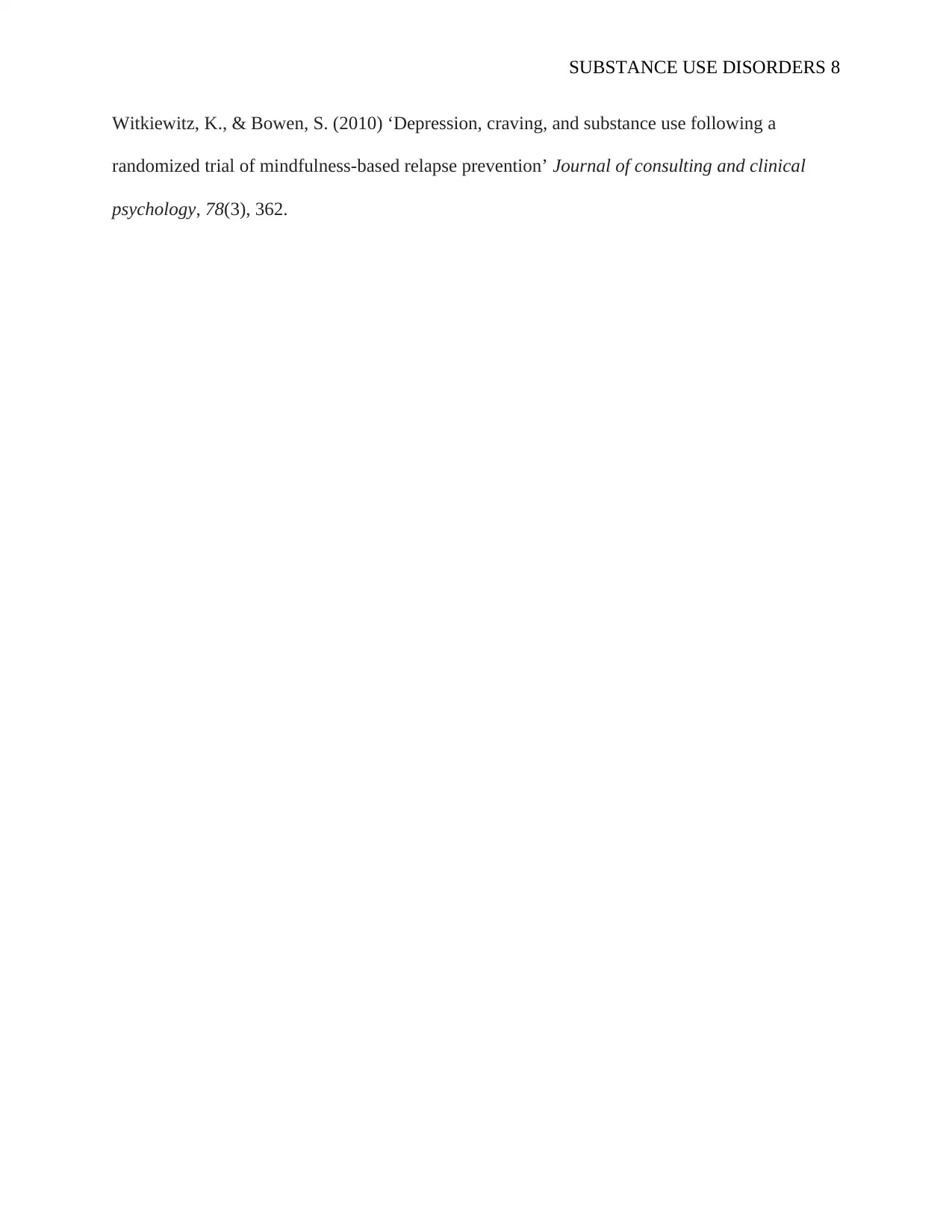
SUBSTANCE USE DISORDERS 8
Witkiewitz, K., & Bowen, S. (2010) ‘Depression, craving, and substance use following a
randomized trial of mindfulness-based relapse prevention’ Journal of consulting and clinical
psychology, 78(3), 362.
Witkiewitz, K., & Bowen, S. (2010) ‘Depression, craving, and substance use following a
randomized trial of mindfulness-based relapse prevention’ Journal of consulting and clinical
psychology, 78(3), 362.
1 out of 8
Related Documents
Your All-in-One AI-Powered Toolkit for Academic Success.
+13062052269
info@desklib.com
Available 24*7 on WhatsApp / Email
![[object Object]](/_next/static/media/star-bottom.7253800d.svg)
Unlock your academic potential
Copyright © 2020–2025 A2Z Services. All Rights Reserved. Developed and managed by ZUCOL.





